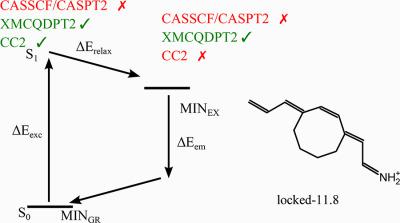当前位置:
X-MOL 学术
›
J. Comput. Chem.
›
论文详情
Our official English website, www.x-mol.net, welcomes your
feedback! (Note: you will need to create a separate account there.)
Initial excited-state relaxation of locked retinal protonated schiff base chromophore. An insight from coupled cluster and multireference perturbation theory calculations
Journal of Computational Chemistry ( IF 3.4 ) Pub Date : 2018-05-04 , DOI: 10.1002/jcc.25346 Dawid Grabarek 1 , Tadeusz Andruniów 1
Journal of Computational Chemistry ( IF 3.4 ) Pub Date : 2018-05-04 , DOI: 10.1002/jcc.25346 Dawid Grabarek 1 , Tadeusz Andruniów 1
Affiliation

|
The initial S1 excited‐state relaxation of retinal protonated Schiff base (RPSB) analog with central C11C12 double bond locked by eight‐membered ring (locked‐11.8) was investigated by means of multireference perturbation theory methods (XMCQDPT2, XMS‐CASPT2, MS‐CASPT2) as well as single‐reference coupled‐cluster CC2 method. The analysis of XMCQDPT2‐based geometries reveals rather weak coupling between in‐plane and out‐of‐plane structural evolution and minor energetical relaxation of three locked‐11.8 conformers. Therefore, a strong coupling between bonds length inversion and backbone out‐of‐plane deformation resulting in a very steep S1 energy profile predicted by CASSCF/CASPT2 calculations is in clear contradiction with the reference XMCQDPT2 results. Even though CC2 method predicts good quality ground‐state structures, the excited‐state structures display more advanced torsional deformation leading to ca. 0.2 eV exaggerated energy relaxation and significantly red shifted (0.4–0.7 eV) emission maxima. According to our findings, the initial photoisomerization process in locked‐11.8, and possibly in other RPSB analogs, studied fully (both geometries and energies) by multireference perturbation theory may be somewhat slower than predicted by CASSCF/CASPT2 or CC2 methods. © 2018 Wiley Periodicals, Inc.
中文翻译:

锁定的视网膜质子化希夫碱发色团的初始激发态弛豫。耦合集群和多参考微扰理论计算的见解
通过多参考微扰理论方法(XMCQDPT2、XMS-CASPT2、XMS-CASPT2)研究了中心C11C12双键被八元环(锁定-11.8)锁定的视网膜质子化希夫碱(RPSB)类似物的初始S1激发态弛豫。 MS-CASPT2) 以及单参考耦合簇 CC2 方法。对基于 XMCQDPT2 的几何结构的分析揭示了平面内和平面外结构演化与三个锁定的 11.8 构象异构体的轻微能量弛豫之间相当弱的耦合。因此,键长反转和主链面外变形之间的强耦合导致 CASSCF/CASPT2 计算预测的非常陡峭的 S1 能量分布与参考 XMCQDPT2 结果明显矛盾。尽管 CC2 方法预测了高质量的基态结构,激发态结构显示出更高级的扭转变形,导致大约 0.2 eV 夸大了能量弛豫和显着红移 (0.4-0.7 eV) 发射最大值。根据我们的研究结果,通过多参考微扰理论(几何和能量)全面研究的locked-11.8以及可能在其他RPSB类似物中的初始光异构化过程可能比CASSCF / CASPT2或CC2方法预测的要慢。© 2018 Wiley Periodicals, Inc. 通过多参考微扰理论充分研究(几何和能量)可能比 CASSCF/CASPT2 或 CC2 方法预测的要慢。© 2018 Wiley Periodicals, Inc. 通过多参考微扰理论充分研究(几何和能量)可能比 CASSCF/CASPT2 或 CC2 方法预测的要慢。© 2018 Wiley Periodicals, Inc.
更新日期:2018-05-04
中文翻译:

锁定的视网膜质子化希夫碱发色团的初始激发态弛豫。耦合集群和多参考微扰理论计算的见解
通过多参考微扰理论方法(XMCQDPT2、XMS-CASPT2、XMS-CASPT2)研究了中心C11C12双键被八元环(锁定-11.8)锁定的视网膜质子化希夫碱(RPSB)类似物的初始S1激发态弛豫。 MS-CASPT2) 以及单参考耦合簇 CC2 方法。对基于 XMCQDPT2 的几何结构的分析揭示了平面内和平面外结构演化与三个锁定的 11.8 构象异构体的轻微能量弛豫之间相当弱的耦合。因此,键长反转和主链面外变形之间的强耦合导致 CASSCF/CASPT2 计算预测的非常陡峭的 S1 能量分布与参考 XMCQDPT2 结果明显矛盾。尽管 CC2 方法预测了高质量的基态结构,激发态结构显示出更高级的扭转变形,导致大约 0.2 eV 夸大了能量弛豫和显着红移 (0.4-0.7 eV) 发射最大值。根据我们的研究结果,通过多参考微扰理论(几何和能量)全面研究的locked-11.8以及可能在其他RPSB类似物中的初始光异构化过程可能比CASSCF / CASPT2或CC2方法预测的要慢。© 2018 Wiley Periodicals, Inc. 通过多参考微扰理论充分研究(几何和能量)可能比 CASSCF/CASPT2 或 CC2 方法预测的要慢。© 2018 Wiley Periodicals, Inc. 通过多参考微扰理论充分研究(几何和能量)可能比 CASSCF/CASPT2 或 CC2 方法预测的要慢。© 2018 Wiley Periodicals, Inc.







































 京公网安备 11010802027423号
京公网安备 11010802027423号